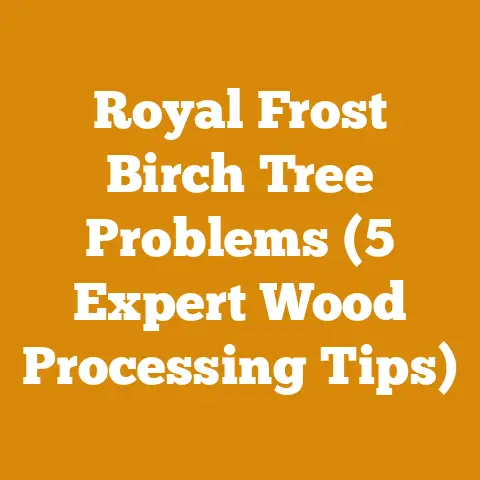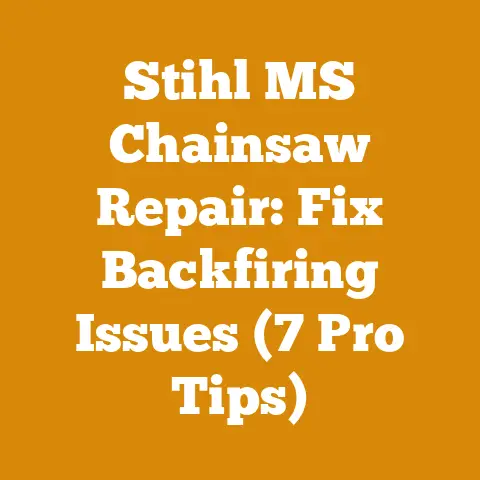How to Get Rid of Poison Ivy Vines on Trees (5 Expert Chainsaw Tips)
I still remember the first time I encountered a massive poison ivy vine snaking its way up an old oak tree in my backyard. It looked almost prehistoric, a thick, hairy beast clinging to the bark. I knew I had to deal with it, but the thought of touching it sent shivers down my spine. Over the years, I’ve developed a few reliable methods for tackling these pesky plants, and I’m eager to share my expertise with you. This guide will cover everything you need to know to safely and effectively remove poison ivy vines from your trees, with a special focus on how to use your chainsaw wisely.
Understanding the Enemy: Poison Ivy Identification and Risks
Before I grab my chainsaw, it’s crucial to know exactly what I’m dealing with. Poison ivy (Toxicodendron radicans) is notorious for its ability to cause an itchy, blistering rash upon contact. This is due to an oil called urushiol found in all parts of the plant – leaves, stems, and roots.
Identifying Poison Ivy
The saying “leaves of three, let it be” is a good starting point, but it’s not foolproof. Here’s a more detailed breakdown:
- Leaves: Typically grow in clusters of three leaflets. The middle leaflet usually has a longer stalk than the two side leaflets. Leaf edges can be smooth, toothed, or lobed, varying even on the same plant.
- Vines: Mature vines can be thick and hairy, clinging tightly to tree trunks. These are the ones I often encounter and need to deal with.
- Berries: In the fall, poison ivy produces small, white or greenish-white berries. Birds love them, which contributes to the plant’s spread.
Risks of Exposure
Urushiol is incredibly potent. Even a tiny amount can cause a severe reaction in sensitive individuals. I’ve learned this the hard way over the years. Here’s what you need to know:
- Sensitivity: Approximately 85% of the population is allergic to urushiol. Sensitivity can develop over time with repeated exposure.
- Transmission: Urushiol can be spread through direct contact with the plant, indirect contact with contaminated objects (tools, clothing), or even through the air if the plant is burned. I always make sure to thoroughly clean anything that might have touched the poison ivy.
- Symptoms: The rash typically appears 12-72 hours after exposure, characterized by redness, itching, swelling, and blisters.
Takeaway: Proper identification and awareness of the risks are the first steps in safely removing poison ivy.
Safety First: Protective Gear and Precautions
I can’t stress this enough: safety is paramount when dealing with poison ivy. Before I even think about grabbing my tools, I gear up.
Essential Protective Gear
- Gloves: I always wear heavy-duty, chemical-resistant gloves. Nitrile or vinyl gloves are good options. Cloth or leather gloves can absorb urushiol and become a source of contamination.
- Protective Clothing: Cover as much skin as possible. Long sleeves, long pants, and a hat are essential. I often wear disposable coveralls for extra protection.
- Eye Protection: Safety glasses or a face shield are crucial to protect your eyes from sap and debris.
- Respirator: If you’re burning poison ivy (which I strongly advise against), a respirator is necessary to prevent inhaling urushiol-containing smoke.
- Boot Covers: Disposable boot covers can prevent urushiol from contaminating your shoes.
Pre-Exposure Precautions
- Barrier Creams: Apply a barrier cream containing bentoquatam (e.g., IvyBlock) to exposed skin before starting work. These creams create a protective layer that helps prevent urushiol from penetrating the skin.
- Know Your Limits: If you’re highly allergic to poison ivy, consider hiring a professional to remove it.
Post-Exposure Procedures
- Wash Immediately: If you think you’ve been exposed, wash the affected area with soap and water as soon as possible. I keep a bottle of dish soap handy for this purpose, as it’s effective at removing oils.
- Tecnu or Zanfel: These over-the-counter washes are specifically designed to remove urushiol from the skin.
- Launder Clothing: Wash all clothing that may have been exposed to urushiol in hot water with detergent. Run an empty cycle in your washing machine afterward to remove any residual urushiol.
- Clean Tools: Wipe down all tools with rubbing alcohol or a degreasing cleaner.
Takeaway: Investing in proper protective gear and following strict safety protocols is essential to prevent poison ivy exposure.
5 Expert Chainsaw Tips for Poison Ivy Vine Removal
Now, let’s get to the heart of the matter: using a chainsaw to remove poison ivy vines safely and effectively. I’ve learned these techniques through years of experience, and they’ve saved me a lot of grief.
Tip 1: The Cut and Treat Method
This is my go-to method for dealing with poison ivy vines on trees. It involves cutting the vine near the base and then treating the cut stump with herbicide to prevent regrowth.
- Procedure:
- Gear Up: Put on all your protective gear.
- Identify the Vine: Locate the main poison ivy vine growing up the tree trunk.
- Cut the Vine: Using your chainsaw, carefully cut the vine as close to the ground as possible. Make sure you have a clear and stable footing. I prefer to use a small, lightweight chainsaw for this task, as it’s easier to maneuver. A 14-inch bar is usually sufficient.
- Dispose of the Cut Vine: Carefully remove the cut section of the vine. Avoid touching it directly. I usually use a long-handled tool to grab it and place it in a heavy-duty trash bag.
- Herbicide Application: Immediately apply a systemic herbicide containing glyphosate or triclopyr to the freshly cut stump. This is crucial to prevent the vine from resprouting. Follow the herbicide manufacturer’s instructions carefully. I typically use a paintbrush to apply the herbicide directly to the cut surface.
- Herbicide Considerations:
- Glyphosate: Effective but non-selective, meaning it can kill other plants if it comes into contact with their foliage. Use with caution near desirable plants.
- Triclopyr: More selective, targeting woody plants. A better choice if you’re concerned about damaging nearby vegetation.
- Concentration: Use a concentrated herbicide solution for best results. I typically use a 20-25% solution.
- Timing: The best time to apply herbicide is when the plant is actively growing, typically in the spring or summer.
- Follow-Up: Monitor the treated stump for regrowth. If new shoots appear, reapply herbicide.
Example: I once had a massive poison ivy vine completely engulfing a young maple tree. I used the cut and treat method, carefully cutting the vine at the base and applying triclopyr. Within a few weeks, the vine above the cut had withered and died, and the maple tree was finally free to thrive.
Metric: I aim for a 100% herbicide coverage on the cut stump surface.
Takeaway: The cut and treat method is a safe and effective way to kill poison ivy vines on trees. The chainsaw is used for the initial cut, while the herbicide prevents regrowth.
Tip 2: Creating a Safe Working Zone
Before I start cutting, I always assess the area and create a safe working zone. This involves clearing away any obstacles and ensuring I have a stable footing.
- Clearing Debris: Remove any rocks, branches, or other debris that could trip you or interfere with your chainsaw.
- Stable Footing: Make sure you have a solid, level surface to stand on. Avoid working on slippery or uneven ground.
- Escape Route: Identify a clear escape route in case of an emergency.
- Bystander Safety: Keep bystanders at least twice the length of the tree away from the work area.
- Tree Lean: Assess the lean of the tree and the direction the vine is growing. This will help you anticipate how the vine will fall when cut.
Example: I was once cutting a poison ivy vine on a leaning tree when a large branch suddenly broke loose and fell in my direction. Fortunately, I had a clear escape route and was able to move out of the way quickly.
Metric: I aim for a clear radius of at least 20 feet around the tree.
Takeaway: Creating a safe working zone is essential to prevent accidents and injuries.
Tip 3: Controlled Cutting Techniques
When using a chainsaw to cut poison ivy vines, it’s crucial to use controlled cutting techniques to avoid kickback and other hazards.
- Sharp Chain: Always use a sharp chain. A dull chain is more likely to kick back. I sharpen my chain regularly using a chainsaw file.
- Firm Grip: Maintain a firm grip on the chainsaw with both hands.
- Body Position: Keep your body to the side of the chainsaw, not directly behind it. This will help you avoid being hit by kickback.
- Cutting Speed: Use a moderate cutting speed. Don’t force the chainsaw through the vine.
- Avoid Pinching: Be careful not to pinch the chain in the cut. If the chain starts to bind, stop cutting and try a different angle.
- Plunge Cut: For thick vines, consider using a plunge cut. This involves carefully inserting the tip of the chainsaw into the vine and then pivoting the saw to complete the cut.
Example: I once experienced a chainsaw kickback while cutting a thick poison ivy vine. Fortunately, I had a firm grip on the saw and was able to control it. However, it was a close call, and it reinforced the importance of using proper cutting techniques.
Metric: I check my chain sharpness after every 15 minutes of cutting.
Takeaway: Controlled cutting techniques are essential for safe and efficient chainsaw operation.
Tip 4: Safe Disposal of Poison Ivy Debris
Proper disposal of poison ivy debris is crucial to prevent further exposure. I never take this lightly.
- Bagging: Carefully collect all cut vines and leaves and place them in heavy-duty trash bags. Seal the bags tightly.
- Double Bagging: For extra precaution, double bag the debris.
- Labeling: Label the bags clearly as “Poison Ivy” to warn others.
- Disposal Options:
- Landfill: The safest option is to dispose of the bags in a landfill.
- Burning: I strongly advise against burning poison ivy, as the smoke can contain urushiol and cause severe respiratory irritation. If you must burn it, do so in a well-ventilated area and wear a respirator. Be aware that burning poison ivy may be illegal in some areas.
- Composting: Do not compost poison ivy, as the urushiol can persist in the compost for years.
- Tool Cleaning: After disposing of the debris, thoroughly clean all tools that may have come into contact with the poison ivy.
Example: I once saw a neighbor burning a pile of brush that contained poison ivy. The smoke drifted into my yard, and several people developed severe rashes. This experience taught me the importance of proper disposal methods.
Metric: I use 3-mil thick trash bags for poison ivy disposal.
Takeaway: Safe disposal of poison ivy debris is essential to prevent further exposure and protect others.
Tip 5: Tree Health Considerations
While removing poison ivy vines is important, it’s also crucial to consider the health of the tree.
- Avoid Girdling: Be careful not to girdle the tree when cutting the vine. Girdling occurs when you cut completely around the trunk, interrupting the flow of nutrients and water.
- Minimize Bark Damage: Avoid damaging the bark of the tree. Bark protects the tree from insects and diseases.
- Monitor for Stress: After removing the poison ivy, monitor the tree for signs of stress, such as wilting leaves or discoloration.
- Fertilize and Water: If the tree shows signs of stress, fertilize and water it to help it recover.
- Professional Consultation: If you’re concerned about the health of the tree, consult with a certified arborist.
Example: I once removed a large poison ivy vine from an old oak tree, but I accidentally damaged the bark in the process. The tree became susceptible to insect infestation, and I had to treat it with insecticide to save it.
Metric: I aim for less than 5% bark damage during vine removal.
Takeaway: Consider the health of the tree when removing poison ivy vines. Avoid girdling and minimize bark damage.
Alternative Methods for Poison Ivy Removal
While I often rely on my chainsaw for cutting poison ivy vines, there are other methods you might consider, depending on the situation.
Manual Removal
This involves pulling the vines off the tree by hand. However, this method is only suitable for small infestations and requires extreme caution.
- Protective Gear: Wear full protective gear, including gloves, long sleeves, long pants, and eye protection.
- Grip: Use a firm grip and pull the vines slowly and carefully.
- Root Removal: Try to remove as much of the root system as possible.
- Bagging: Dispose of the vines in heavy-duty trash bags.
Herbicide Application (Foliar Spray)
This involves spraying the poison ivy foliage with herbicide. However, this method can be difficult to apply without damaging desirable plants.
- Selective Herbicides: Use a selective herbicide that targets broadleaf plants.
- Shielding: Shield desirable plants from overspray.
- Weather Conditions: Apply herbicide on a calm day to prevent drift.
- Multiple Applications: Multiple applications may be necessary for complete control.
Vinegar and Salt Solution
Some people recommend using a mixture of vinegar, salt, and dish soap to kill poison ivy. However, this method is not always effective and can damage the soil.
- Mixture: Mix 1 gallon of vinegar, 1 cup of salt, and 1 tablespoon of dish soap.
- Application: Spray the mixture directly on the poison ivy foliage.
- Soil Damage: Be aware that this mixture can damage the soil and kill other plants.
Takeaway: Manual removal, herbicide application (foliar spray), and vinegar/salt solutions are alternative methods for poison ivy removal, but they may not be as effective or safe as the cut and treat method.
Chainsaw Maintenance for Poison Ivy Removal
After using my chainsaw to remove poison ivy vines, I always give it a thorough cleaning and maintenance check. This helps to prevent the spread of urushiol and ensures that my saw is ready for the next job.
Cleaning the Chainsaw
- Wipe Down: Wipe down the entire chainsaw with rubbing alcohol or a degreasing cleaner. Pay particular attention to the bar, chain, and handles.
- Chain Cleaning: Remove the chain and soak it in a degreasing solution. Scrub the chain with a brush to remove any sap or debris.
- Air Filter: Clean the air filter regularly. A dirty air filter can reduce the chainsaw’s performance.
- Spark Plug: Check the spark plug and replace it if necessary.
Chainsaw Maintenance
- Chain Sharpening: Sharpen the chain regularly. A sharp chain is essential for safe and efficient cutting.
- Bar Lubrication: Keep the bar lubricated with chainsaw bar oil.
- Fuel Mixture: Use the correct fuel mixture for your chainsaw.
- Storage: Store the chainsaw in a dry place.
Metric: I clean my chainsaw after every use and perform a full maintenance check every 25 hours of operation.
Takeaway: Regular chainsaw cleaning and maintenance are essential for preventing the spread of urushiol and ensuring the saw’s longevity.
Long-Term Prevention Strategies
Once I’ve removed the poison ivy vines from my trees, I want to prevent them from coming back. Here are some long-term prevention strategies I’ve found helpful.
Monitoring
Regularly inspect your property for new poison ivy growth. The earlier you catch it, the easier it is to remove.
Ground Cover
Plant ground cover plants around the base of trees to compete with poison ivy. Some good options include:
- Pachysandra: A shade-tolerant ground cover that spreads quickly.
- Vinca Minor: Also known as periwinkle, this ground cover has attractive blue flowers.
- Creeping Thyme: A low-growing ground cover with fragrant leaves.
Mulching
Apply a thick layer of mulch around the base of trees to suppress weed growth, including poison ivy.
Education
Teach family members and neighbors how to identify poison ivy and avoid contact with it.
Takeaway: Long-term prevention strategies, such as monitoring, ground cover, mulching, and education, can help keep poison ivy at bay.
Legal Considerations
Before I start removing poison ivy, I always check local regulations regarding herbicide use and disposal of plant material.
Herbicide Regulations
Some areas have restrictions on the use of certain herbicides. Check with your local authorities to ensure that you’re using approved products.
Disposal Regulations
Some areas have specific regulations regarding the disposal of plant material. Check with your local waste management company for guidance.
Property Lines
Be careful not to trespass on neighboring properties when removing poison ivy. If the vines are growing on a property line, communicate with your neighbor before taking any action.
Takeaway: Be aware of local regulations regarding herbicide use and disposal of plant material.
Conclusion: Mastering Poison Ivy Vine Removal with Chainsaw Expertise
Dealing with poison ivy vines on trees can be a challenging task, but with the right knowledge and tools, it’s a manageable one. I’ve shared my expert chainsaw tips, safety precautions, and alternative methods to help you tackle this problem effectively. Remember, safety is always the top priority. By following these guidelines, you can protect yourself, your trees, and your property from the harmful effects of poison ivy. Now, go forth and conquer those vines, armed with your newfound knowledge and a well-maintained chainsaw!






